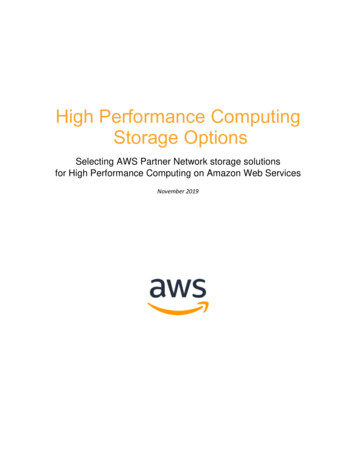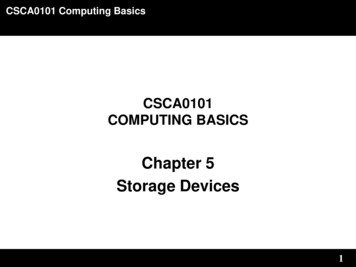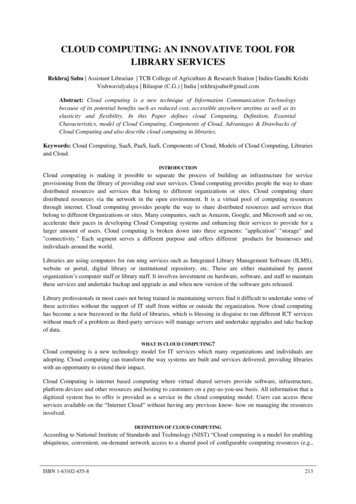
Transcription
High Performance ComputingStorage OptionsSelecting AWS Partner Network storage solutionsfor High Performance Computing on Amazon Web ServicesNovember 2019
2019, Amazon Web Services, Inc. or its affiliates. All rights reserved.NoticesThis document is provided for informational purposes only. It represents AWS’s currentproduct offerings and practices as of the date of issue of this document, which are subject tochange without notice. Customers are responsible for making their own independentassessment of the information in this document and any use of AWS’s products or services,each of which is provided “as is” without warranty of any kind, whether express or implied.This document does not create any warranties, representations, contractual commitments,conditions or assurances from AWS, its affiliates, suppliers or licensors. The responsibilitiesand liabilities of AWS to its customers are controlled by AWS agreements, and this documentis not part of, nor does it modify, any agreement between AWS and its customers.
ContentsNoticesiiiAbstractvIntroduction1HPC Storage1AWS Storage Services2Amazon S32Amazon EBS3Amazon EC2 Instance Store4Amazon FSx for Lustre4Amazon EFS4AWS Partner Solutions5WekaIO Matrix5Qumulo QF27IBM Spectrum rther Reading14Document Revisions15
AbstractHigh Performance Computing (HPC) is an important and complicated workload for manycustomers. Many HPC workloads incorporate large compute clusters and need to process a lotof data. HPC workloads require storage systems that can keep up with performance andcapacity demands. This paper explores storage options when running HPC workloads onAmazon Web Services (AWS).
Amazon Web Services – AWS Partner Network High Performance Computing Storage OptionsIntroductionHPC can take many forms across many industries. Technical computing is present in everythingfrom electronics design and manufacturing to genomics and film rendering. HPC often meansmassively parallel compute clusters used to analyze existing data or generate new data. Ineither case, data needs to be acted upon and persisted by each node in a cluster as fast aspossible. Many HPC workloads run for a long time and take checkpoints. These checkpointscreate large amounts of intermediate data, but enable snapshotting and restarting in case ofinterruption. This is particularly important on the cloud, where specialized offerings likeAmazon Elastic Compute Cloud (EC2) Spot Instances may incorporate temporary resourceshortages as a tradeoff to being extremely cost-effective.There are many benefits of running HPC on AWS, and for more information about the benefitssee the HPC section of the AWS website1. In this document, we explore HPC from a storageperspective. Cluster management and other compute aspects are out of scope for this paper,but addressed in the introduction to HPC on AWS whitepaper2 for those interested in learningabout schedulers and solvers on AWS.HPC StoragePrograms that run in HPC clusters usually require shared access to storage. Any program onany compute node can read from and write to any file or parts of any file. Because the read orwrite operation could come from anywhere, storage architectures for HPC workloads aim toavoid potential performance bottlenecks. Distributed locking systems and parallel access tometadata and data help keep things working at high speed. Add to that low latencynetworking and high-performance media, and it’s a formula for success. AWS componentry isan easy way to get started with HPC storage on the cloud, and can be used in conjunction withintegrated solutions from AWS Partner Network (APN) Technology Partners. For background,let’s briefly examine the anatomy of a distributed parallel cluster.A file system understands how to map a file hierarchy and its contents to physical media, suchas a drive. Only a single host can request a file. Even if the host is a Network File System (NFS)server, the NFS server software arbitrates remote requests from clients to become localrequests. The media could be a physical device or an aggregate of devices presented as alogical device, like in a Storage Area Network (SAN).A distributed file system spans more than one set of logical media, but requests are stillterminating in one point. NFS servers are a good example of this, because an NFS client onlyknows how to access the NFS server without understanding the underlying physical topologyor having any way to access it.A clustered file system allows multiple hosts to access the same data at the same time, fullysupporting concurrent reads and writes and arbitrating any contention. In this model, everyparticipating host can make requests, but hosts find responses on the same shared media. InPage 1
Amazon Web Services – AWS Partner Network High Performance Computing Storage Optionsclustered environments, participating hosts often export the shared namespace as anetworked resource. Requests coming from remote clients always terminate on the limitednumber of participating hosts, like in the simple case of a single host acting as an NFS server.A clustered distributed file system builds on these concepts by breaking data into pieces andspreading file system data across multiple hosts and multiple media. This does a better job ofequalizing capabilities, because each participating host doesn’t have to compete with otherhosts for access to storage media. Requests are routed through specific hosts depending onwhich piece of data is needed. A clustered distributed system still might have a requesthandling bottleneck if the data being requested doesn’t vary. This is referred to as a hot spot.In a scenario where participating hosts re-export their file system to the network, remoteclients asking for the same piece of data would cause all requests to be routed through thesame host irrespective of which of host terminates the client connection.To solve for this, parallel file systems support a many-to-many relationship between requestsand responses. Every participating host can initiate or service requests, accessing data throughmany independent pathways. They work together to provide a single file system hierarchy, ornamespace. This grid or mesh includes a special client software to decipher the file systemnamespace and inform even remote clients as to the topology of the data layout. By avoidingany form of request serialization, parallel file systems historically have provided the bestperformance for HPC workloads. Before the cloud, it was common to see parallel file systemstalk to clients via a front-end network, and utilize a segregated back-end network for behindthe-scenes data access. Reliability was generally handled by underlying storage systems, oftencomplex and expensive SAN topologies.The advent of the cloud and storage solutions designed for the cloud greatly simplifies thedeployment and configuration process for HPC workloads. In addition to scaling performanceand capacity, distributed parallel file system clusters in the cloud also take fault tolerance intoconsideration. Participating hosts are fully aware of device health and have mechanisms inplace to minimize interruptions in the event of component failure, thanks to the client’sunderstanding of what is happening behind the scenes.AWS Storage ServicesAWS provides several storage services useful for HPC. Some can be used on their own, whileothers are building blocks for APN Partner solutions. What you choose depends largely on yourworkload attributes. The best way to validate your storage choice is to try your workload.Benchmarks and other synthetic measurements are rarely adequate in the tailored and everchanging world of HPC.Amazon S3Companies today need the ability to simply and securely collect, store, and analyze their dataat a massive scale. Amazon Simple Storage Service (S3) is object storage built to store andPage 2
Amazon Web Services – AWS Partner Network High Performance Computing Storage Optionsretrieve any amount of data from anywhere – websites and mobile applications, corporateapplications, and data from Internet of Things (IoT) sensors or devices3. Amazon S3 delivers99.999999999% durability, and stores data for millions of applications used by market leadersin every industry. Amazon S3 also provides comprehensive security and compliancecapabilities that meet even the most stringent regulatory requirements, giving customersflexibility in the way they manage data for cost optimization, access control, and compliance.Amazon S3’s query-in-place functionality allows you to run powerful analytics directly on yourdata at rest in Amazon S3. Lastly, Amazon S3 is the most supported cloud storage serviceavailable, with solutions available from a large community of third-party solution providers,systems integrator partners, and other AWS services.Amazon S3 is a highly scalable and high durable storage platform for HPC applications thatsupport an object interface. Amazon S3 includes many features, such as lifecycle management,that allow you to move less frequently accessed down to lower storage tiers for more costeffective solution4. Even if your HPC application does not directly support Amazon S3, you canuse Amazon S3 as a data repository to hold your dataset, which can be ingested into yourprocessing file system. There also are APN Partner solutions that provide traditional filesystemaccess via SMB, NFS, and POSIX clients while using Amazon S3 as part of their solution for datastorage and/or data protection.Amazon EBSAmazon Elastic Block Store (EBS) provides persistent block storage volumes for usewith Amazon EC2 instances in the AWS Cloud. Each Amazon EBS volume is automaticallyreplicated within its Availability Zone (AZ) to protect you from component failure, offering highavailability and durability. Amazon EBS volumes offer the consistent and low-latencyperformance needed to run your workloads. With Amazon EBS, you can scale your usage up ordown within minutes – all while paying a low price for only what you provision.If you want to either build your own local or network file system or utilize an APN Partnersolution, Amazon EBS provides block storage to your Amazon EC2 compute instances. AmazonEBS includes different performance characteristics, such as IOPS optimized Provisioned IOPSSSD (i01) volumes where customers can pre-provision the IO they need, and ThroughputOptimized HDD (st1) volumes that are designed to be used with workflows that are drivenmore by throughput than IOPS.Pro Tip: Aside from the IOPS and/or throughput the volumes provide, when using multiplevolumes, it is important to consider the maximum performance the Amazon EC2 instance canprovide. Amazon EBS optimized instances have published maximums that should beconsidered when choosing the instance on which to run your storage solution5.Page 3
Amazon Web Services – AWS Partner Network High Performance Computing Storage OptionsAmazon EC2 Instance StoreAn instance store provides temporary block-level storage for your instance. This storage islocated on disks that are physically attached to the host computer. Instance store is ideal fortemporary storage of information that changes frequently, such as buffers, caches, scratchdata, and other temporary content, or for data that is replicated across a fleet of instances,such as a load-balanced pool of web servers.Amazon EC2 Instance Store, like Amazon EBS, provides non-persistent block storage local toinstances. An instance store provides high-speed local disk storage that can serve custom-builtsolutions for processing data that does not need to be persisted. Instance stores also are usedby some APN Partner solutions that stripe data across multiple instances.Amazon FSx for LustreAmazon FSx for Lustre is a new, fully managed service provided by AWS based on the Lustrefile system. Amazon FSx for Lustre provides a high-performance file system optimized for fastprocessing of workloads such as machine learning, high performance computing (HPC), videoprocessing, financial modeling, and electronic design automation (EDA).FSx for Lustre allows customers to create a Lustre filesystem on demand and associate it to anAmazon S3 bucket. As part of the filesystem creation, Lustre reads the objects in the bucketsand adds that to the file system metadata. Any Lustre client in your VPC is then able to accessthe data, which gets cached on the high-speed Lustre filesystem. This is ideal for HPCworkloads, because you can get the speed of an optimized Lustre file system without having tomanage the complexity of deploying, optimizing, and managing the Lustre cluster.Additionally, having the filesystem work natively with Amazon S3 means you can shut downthe Lustre filesystem when you don’t need it but still access objects in Amazon S3 via otherAWS Services. FSx for Lustre also allows you to also write the output of your HPC job back toAmazon S3.Amazon EFSAmazon Elastic File System (EFS) provides simple, scalable, elastic file storage for use with AWSCloud services and on-premises resources. It is easy to use and offers a simple interface thatallows you to configure file systems and get started in mere moments. Amazon EFS is built toelastically scale based on usage. Like Amazon S3, you just use Amazon EFS—no provisioningrequired. The high performance sweet spot of Amazon EFS is aggregate throughput, cateringto parallelized, read-heavy workloads. Behind the scenes, Amazon EFS enhances its capabilitieswithout disrupting applications to handle additional capacity and load requirements. As aregional service, Amazon EFS is designed for high availability and durability storing dataredundantly across multiple AZs.Page 4
Amazon Web Services – AWS Partner Network High Performance Computing Storage OptionsAmazon EFS presents an NFSv4 export that can be used as working storage, as a repository, orin conjunction with other services to provide a fully managed storage solution. Amazon EFSrecently announced provisioned throughput, which allows you to increase throughputdisproportionately to capacity, so even smaller storage capacity workloads can take advantageof Amazon EFS’ scale and ease of use.AWS Partner SolutionsAPN Technology Partners provide different solutions for supporting HPC workloads, includingthe Partner solutions listed below. Check out the APN site to learn more about APN partners6.WekaIO MatrixWekaIO has a product called Matrix, which is a scale-out NAS platform. Matrix was designedspecifically for the AWS Cloud, and was built with optimization in mind. Matrix can run on AWSas well as on premises. MatrixFS, which is the underlying file system of the Matrix NAS, is adistributed parallel file system. Matrix includes many features that customers would expectfrom a scale-out NAS system, including a Global Name Space, support for NAS protocols likeNFS and SMB, and ability to scale both performance and capacity. Some key differentiators forMatrix include linear performance scalability, seamless tiering with Amazon S3, snapshottingto Amazon S3 with the ability to snapshot the whole cluster, and use of a native client toprovide true parallel processing across multiple nodes (currently only available for Linux).ArchitectureFrom an architectural perspective on AWS, Matrix runs “I” instance families for the storagecomponents while the client can run on any instance family, allowing for a wide range ofworkloads. Matrix requires a minimum of six nodes to have a fully formed cluster. Under thecovers, Matrix software runs inside a container, which allows it to discreetly mange itsresources so it can either be installed on instances by itself or alongside other applications in ahyperconverged deployment. Matrix has configurable redundancy from N 2 to N 4 and canscale from the base six nodes up to 1,000s of nodes. MatrixFS distributes all data andmetadata across the nodes in the cluster. Matrix is designed to have an active tier of data oninstance storage and an inactive tier on Amazon S3. While tiering is optional and a cluster canbe run with only an active tier on SSD, it is recommend that most implementations use theAmazon S3 tier, which can enabled any time after the cluster is running.Pro Tip: AWS provides instances with enhanced networking up to 100Gbps per instance.WekaIO supports the I3EN instances for storage nodes, which provide instance storage just likethe I3 instances but with enhanced networking. The i3en.24xlarge and i3en.metal instancetypes provide 100Gbps. Combine these instance types with client instances that support100Gbps to provide extremely high, single client throughput that can optimize HPC workloadsneeding to fully utilize CPUs and GPUs and remove storage bottlenecks. AWS instance typesthat support enhanced networking up to 100Gbps now include I3en, C5n, M5n, M5dn, R5n,Page 5
Amazon Web Services – AWS Partner Network High Performance Computing Storage OptionsR5dn, and P3dn. AWS innovates at a rapid pace be sure to check the Amazon EC2 instancetype page7 for information on the latest instance types.Figure 1: Weka IO MatrixFS ClusterWhen to use: WekaIO provides distributed parallel file system performance andAmazon S3 persistent without the need for tuning. While you can achieve the maximumperformance by utilizing the WekaIO client for Linux, this solution supports high-speedworkloads over NFS and SMB, just not parallel. This makes it a good solution for most HPCworkloads. Because of the way WekaIO stores data and metadata, its solution also is usefulfor mixed workloads, including small I/O workloads. You can take snapshots of the file systemto Amazon S3 to enable cluster shutdown while retaining the data.For more information on Matrix, visit the WekaIO Website8. You also can visit start.weka.io toquickly size a cluster based on capacity or performance needs9. WekaIO can be deployed viathe AWS Marketplace10.Page 6
Amazon Web Services – AWS Partner Network High Performance Computing Storage OptionsQumulo QF2Qumulo File Fabric (QF2) is a software-defined, scale-out NAS system. It offers a balance ofperformance, scalability and ease of use. QF2 has a simple graphical user interface (GUI) aswell as full REST API, making it easy to manage. QF2 can run on premises and on AWS and itoffers a continuous replication feature, which allows a QF2 cluster running on premises to bein sync with a QF2 cluster running on AWS and/or between QF2 clusters running in multipleAWS locations. QF2 also includes built-in file level analytics so that users can quickly queryinformation about files and visualize performance metrics down to the client, user, and filelevel.ArchitectureA base QF2 cluster requires either four, six, or 10 nodes. You can add additional nodes at anytime as an online operation. On AWS, these nodes are Amazon EC2 instances running the QF2software. Each node in the cluster has a certain amount of Amazon EBS storage, which is usedto persist the data. QF2 instances can use a combination of SSD- and HDD-based Amazon EBSvolumes to balance performance and cost. Clients access the cluster through NAS protocols,such as SMB or NFS. Clients can access any data through any node regardless of where thedata resides. QF2 does not have a custom client at this time, so when managing clientdistribution, it is helpful to use a domain name system (DNS) such as Amazon Route 53 or gothrough a load balancer11.Figure 2: Qumulo QF2 20-Node Deployment TopologyPage 7
Amazon Web Services – AWS Partner Network High Performance Computing Storage OptionsWhen to use: Qumulo is an ideal solution for any HPC cluster that requires data processing byheterogeneous compute systems. Qumulo provides multi-protocol support with SMB and NFSprotocols, so data can be natively accessed by both Windows and Linux nodes. An additionalconsideration would be balancing traffic between the nodes. DNS with network protocols likeNFS and SMB do not provide the same parallelism as a POSIX-based parallel client. QF2 doesallow traffic to be balanced between nodes and should be used with HPC clusters that can bedistributed and handle balancing requests between nodes. Qumulo currently does not supportAmazon S3, so all data resides on Amazon EBS volumes. If you need to store data or read datafrom Amazon S3 for durability, tiering, or other purposes, you will need to utilize custom codeor a third-party tool.For more information about QF2, see the QF2 Overview12 on Qumulo’s website or downloadthe technical whitepaper13. QF2 also is available on AWS Marketplace as a free single nodetrial14, 5TB per node version15, 20TB per node version16, and 30TB per node version17.IBM Spectrum ScaleIBM Spectrum Scale is a scalable clustered file system based on IBM’s General Parallel FileSystem (GPFS) and associated management software and clients.IBM Spectrum Scale de-coupled architecture allows configuration options that can scale ondifferent vectors, including: performance (bandwidth and IOPS) of the data and metadatalayers, capacity, and number of nodes that can mount the file system.Figure 3: General Architecture Components of IBM Spectrum ScaleFigure 3 depicts the general architecture components of the IBM Spectrum Scale cluster.Page 8
Amazon Web Services – AWS Partner Network High Performance Computing Storage OptionsOne of the key GPFS functions within Spectrum Scale is the ability to ship IO requests tocompute nodes using the Network Shared Disk (NSD) protocol. NSD is a client-server protocol,with NSD servers providing access to storage that is visible on servers as block storage. Atypical GPFS cluster comprises of a smaller number of NSD servers and a large number of NSDclients.IBM Spectrum Scale provides various configuration options and access methods through theclient. These include traditional POSIX-based file access with features such as snapshots,compression, and encryption.ArchitectureWhen deploying a cluster on AWS using the AWS Quick Start, a full architecture is deployed, asshown in Figure 4. The architecture features autoscaling groups for the IBM Network SharedDisk (NSD) storage service instances - listed as “Server Instances” - and the IBM Spectrum Scalecompute instances. While not shown in Figure 4, there are Amazon EBS volumes associated toeach NSD instance to provide the storage as shown in Figure 3.Figure 4: IBM Spectrum Scale Quick Start ArchitectureThe AWS Quick Start includes automatic deployment of AWS services and instance roles in theIBM Spectrum Scale cluster architecture. For more information on the AWS Quick Startdeployment, visit the Quick Start site.Page 9
Amazon Web Services – AWS Partner Network High Performance Computing Storage OptionsPro Tip: For data protection purposes with the AWS solution, it is imperative that your VPC hastwo private subnets in different AWS AZs. Also, the data replica parameter is set to two(default) or more and should not be lowered if data protection is a concern. It also isimportant for data protection purposes that the cluster not run in a degraded state for anylength of time if data is lost in a single AZ. Prioritizing the health of the cluster is critical torunning Spectrum Scale on the AWS Cloud.For HPC workloads, Spectrum Scale fits when many different compute hosts must have accessto the same data. This is the fundamental benefit provided by a single namespace offered bySpectrum Scale. With a single namespace, a file can be addressed by a uniform file path,regardless of where the file is located, or from where the file is accessed in the cluster.The single namespace also can be extended, including from on premises, with optional add-onfeatures such as the data tiering feature Transparent Cloud Tiering (TCT) and universal clientsupport to the filesystem. With Universal Client support, Spectrum Scale runs on Linux, AIX,and Windows clients to allow native file system access. Also, when export services enabled fora Spectrum Scale cluster, clients can access data using NFS, SMB, and Amazon S3 API.Spectrum Scale also provides POSIX and HDFS.When to use: Spectrum Scale should be used in hybrid workloads where Spectrum Scale isbeing used on premises. Utilizing the cloud tiering feature as part of a single namespace makesbursting of HPC clusters simple. Additionally, because Spectrum Scale requires advancedconfiguration to set up and maintain, it is ideal for existing customers with expertise in thisconfiguration. Spectrum Scale also is good when customers need flexibility of configuration,because it can scale on different dimensions.For more information and to get started with spectrum scale, see the IBM Spectrum Scale onAWS Quick Start.18LustreLustre is an open source file system originally developed by Carnegie Mellon University andfunded by the United States Department of Energy. Lead development for the platform haschanged multiple times over the years. Most recently, Lustre was owned by Intel and wasacquired by DataDirect Networks (DDN) in June 2018. Lustre often is used as part of HPCworkloads because it is a parallel distributed file system that can provide a POSIX compliantfile system with scalable performance and capacity. Commercial technical support for Lustre isoften is bundled along with the computing system or storage hardware.ArchitectureLustre uses external metadata, but it is object based not block based. A Lustre file systemcomprises several components, which include Metadata Servers (MDS), Metadata Targets(MDT), Object Storage Servers (OSS), Object Storage Targets (OST), Management Server(MGS), Management Target (MGT), and the Lustre clients. The MDS and OSS provide thePage 10
Amazon Web Services – AWS Partner Network High Performance Computing Storage Optionsaccess layer for the metadata and data, respectively. In kind, the MDT and OST provide theactual data storage. Because Lustre provides a file system to the client but is object based, filesare ultimately stored in one or more objects, and the objects are stored on an OST. The Lustreclient software plays an important role as well. The file system is accessed via the clientsoftware and not via a network protocol like NFS/SMB. The client handles providing a singlenamespace for data spread across multiple OSTs, and the file system can handle multipleclients reading or writing to different parts of the same file at the same time.Figure 5: Lustre Reference ArchitectureOn AWS, Lustre is generally deployed on Amazon EC2 instances and uses Amazon EBS for theunderlying disk storage. The size of instances, as well as the type of Amazon EBS volumes,should be taken into account when designing a solution to meet performance requirementsfor the HPC cluster. Amazon EBS has four different volume types (details on the EBS website),which include a variety of performance options. You should take into account AZs whenbuilding a Lustre solution on AWS to meet your performance and availability requirements.When to use: Lustre is a good solution for high-speed parallel HPC workloads. Since Lustre hasno built-in data protection mechanism, precautions should be taken to persist data in AmazonS3. Monitoring for and addressing failed componentry are important. Lustre requires advancedconfiguration and design for optimal performance. Lustre is good for existing Lustrecustomers, who also have experience with AWS compute and storage services to optimize thecluster properly. For more information about Lustre visit lustre.org19 This section applies toPage 11
Amazon Web Services – AWS Partner Network High Performance Computing Storage Optionsself-managed version of Lustre. AWS now provides a fully managed version of Lustre asdescribed previously in the Amazon FSx for Lustre section of this whitepaper.BeeGFSBeeGFS, developed by ThinkParQ, is a parallel cluster file system that runs on Linux. BeeGFS isan open source, software defined storage system that runs on Linux distributions. BeeGFSprovides a Linux-based client to allow parallel access to the file system.ArchitectureBeeGFS, similar to other parallel file systems, uses external metadata. There are four servicesthat make up BeeGFS: the management service, which holds information for and monitors theother services; the storage service that hosts the data; the metadata service that stores accesspermissions and striping information; and the client service, which handles mounting andaccessing the data. The storage service works on any local POSIX file system. BeeGFS, shownbelow in Figure 5, uses all available random access memory (RAM) for cache, so it benefitsfrom additional memory for read access to hot data.Page 12
Amazon Web Services – AWS Partner Network High Performance Computing Storage OptionsFigure 5: BeeGFS ArchitectureWhen to use: BeeGFS, like several parallel file systems, offers a POSIX-compliant file systemclient. Since BeeGFS is free, open source software it can provide a cost-effective solution forcustomers who require high speed parallel file system solutions on AWS who typically utilizeopen source software as part of their HPC solutions.For more information on BeeGFS see beegfs.io20. You also can find details on a building ascalable deep learning workload with BeeGFS on the AWS Blog21.ConclusionThere are many options for deploying HPC storage on AWS to support virtually any HPCworkload. Each offering uses different AWS services to provide highly performant, scalable,and cost-optimized solutions. Native AWS services, as well as APN partner solutions, allow youto take advantage of the agility of AWS and deploy an HPC workload quickly in geographiclocations around the world, including locations specifically designed for the public sector.Page 13
Amazon Web Services – AWS Partner Network High Performance Computing Storage OptionsReceive benefits from bursting your HPC workloads from on-premises to running wholeworkloads on AWS.ContributorsThe following individuals and organizations contributed to this document:
High Performance Computing (HPC) is an important and complicated workload for many customers. Many HPC workloads incorporate large compute clusters and need to process a lot of data. HPC workloads require storage systems that can keep up with performance and capacity demands. This paper explores storage options when running HPC workloads on










